Disclosure: Meeple Mountain received a free copy of this product in exchange for an honest, unbiased review. This review is not intended to be an endorsement.
I know that not everyone loves dice chuckers, but there’s something satisfying about grabbing a handful of dice and rolling them across the table. Particularly when those dice influence the actions of 500 foot tall monsters duking it out in a major metropolitan area; like in 2011’s King of Tokyo. The series has had a slew of releases over the years: from “monster packs” (promo cards featuring new monsters), to brand new titles like King of New York, and even a reimagining of the original in 2024’s King of Tokyo: Origins. But the game has been largely the same since the original was released: 2-6 players going head to head trying to come out on top. But now with the release of King of Monster Island, the series has gone coop, with players all trying to defeat a fire monster born from the depths of a volcano on an island in the middle of the Pacific.
Way to set the stage!

King of Monster Island Overview
The first thing you’ll notice when sitting down to play is the enormous volcano in the center of the player board. Cleverly assembled from cardboard and plastic, this is not only the centerpiece of the game, but also acts as a dice tower, divvying out the dice which get tossed inside it all over the board (more on that in a moment).
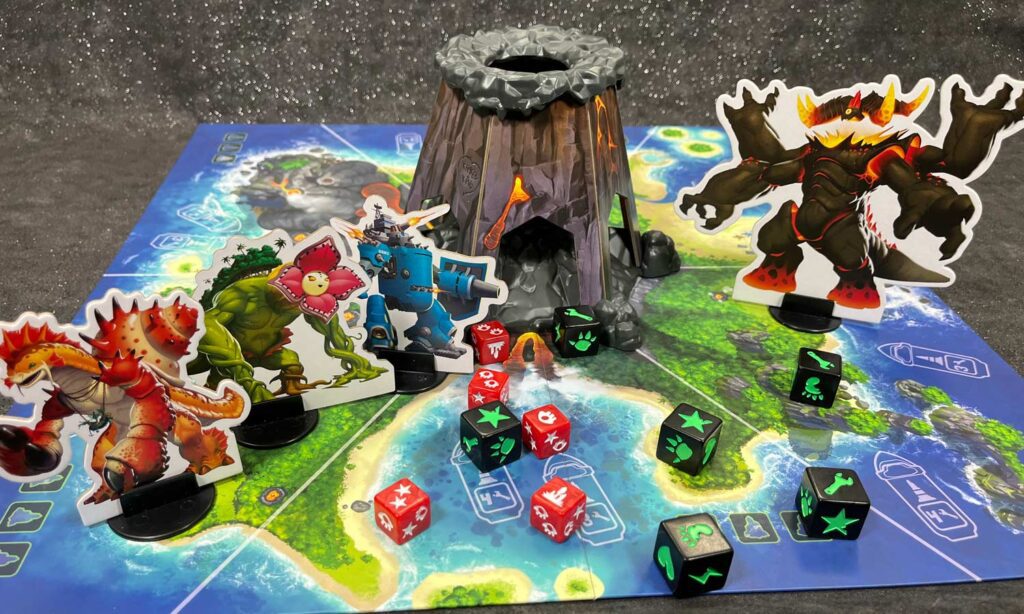
The goal of the game is for the group of monsters (you, the players) to attack and defeat the boss monster (no, not that one), and all their minions (more on these in a moment). If at the end of a player’s turn, the boss monster’s health is at zero, then hurray you can all go back to attacking each other in Tokyo Bay. If, however, any of the players health is at zero at the beginning of their turn, or the boss builds 3 “Pylons” on the board, or there are no minions in the draw bag, you all fail and are sacrificed into the volcano (okay that last bit was embellishment, but what else do you think was going to happen?).
Collectively, the players select their monster standees, player cards, and health / star counters. Then in order, players will put their standee on the board such that no two monsters share a space. And then the game begins.
Who’s The Boss?
Since “the boss” is the star of the show, let’s take a quick look at the roster. The game comes with 3 bosses, each with their own standee, double-sided player card, and health/star counter device. The top left corner of each card shows the number of dice the boss gets to roll during the boss phase, and the boss’s health.
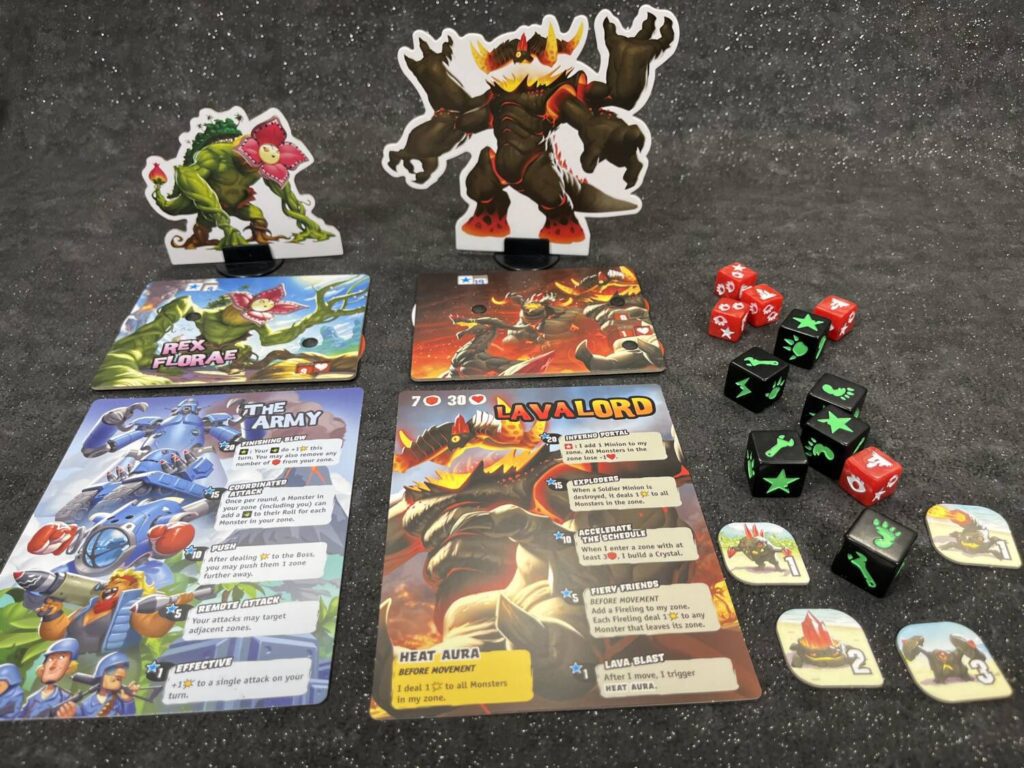
The bosses increase in strength and health from the “easy” Crystal Dragon (whose base side has only 15 measly health), to Lithosaur, and all the way up to the insane side of the LavaLord with 35 health.
The Boss Phase – Was it Angela, or was it Tony all along?
The first part of each player’s turn is known as the “boss phase”. During this phase the active player (okay, it’s you, you handsome devil) collects all unused boss dice (the beautiful pearlescent red dice that you’ll learn to hate) and sacrifices throws them into the volcano. The volcano disperses the dice onto the six different zones of the island; some zones might have 2 or 3, while other zones have none.
The boss will then move around the board based on a combination of proximity to dice and / or minions (we’re almost there, promise).
When the boss movement comes to a stop, you’ll activate any minions in that slice of paradise. Minions come in 4 varieties:
- Soldiers – attack all monsters in “this zone” for 1 damage.
- Cannons – attack all monsters, anywhere on the island for 1 damage
- Shield – no attack, but they protect Soldiers, Cannons, and the Boss from attack.
- Builder – builds a red crystal in this zone. If 2 red crystals already exist in this zone, then it becomes a Pylon instead.
Finally, any boss dice sharing the zone with La Jefa herself are activated. The sides possibilities range from adding minions to the current zone, adding stars to the boss’ card, or even adding a red crystal (same rules for the builder apply here).
And only then do you, my fine feathered, scaley, hairless friend, get to perform your actions.
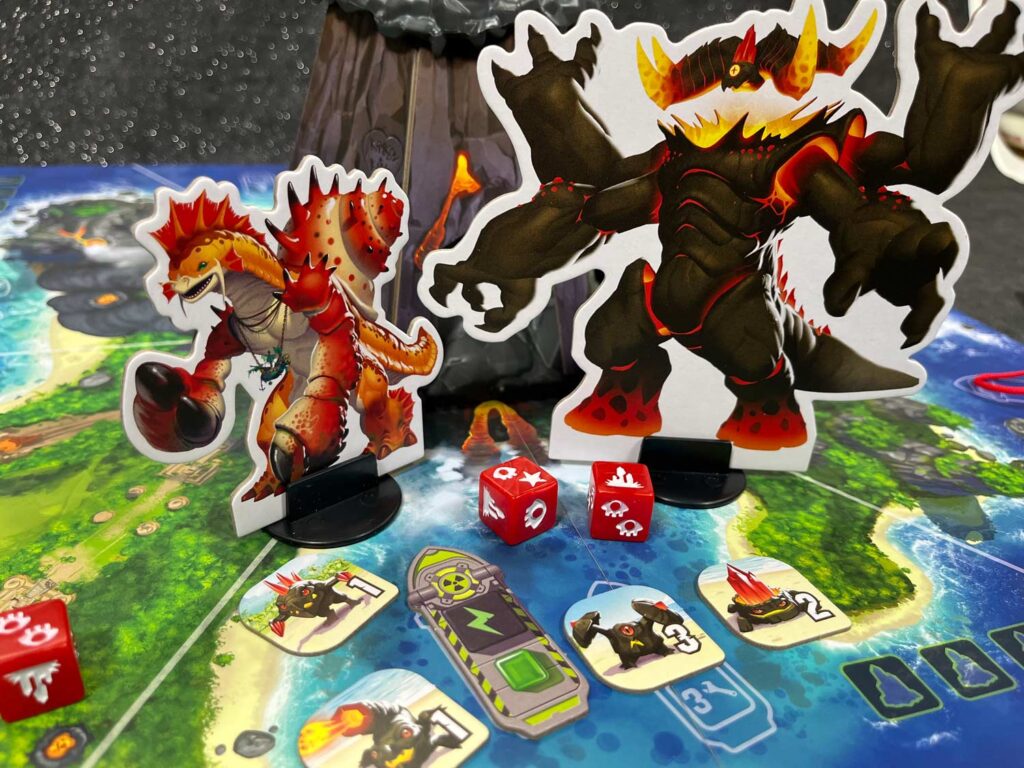
Can you win the game in a single turn? No you cannot!
If you’re already familiar with King of Tokyo, there’s not much difference in basic gameplay. But let’s give you the elevator pitch for completeness.
On your turn you’re going to roll 6 monster dice (or more if you’re lucky). These dice feature a mix of health, energy, stars, feet, claws, and a wrench (new to this game). In true Yahtzee fashion you can reroll any number of dice up to two more times.
Once you’ve settled on your dice faces, you can do your actions.
- Feet allow you to move towards (or away from the boss – you coward), or if you’re in the same space as the boss can also be used to deal a single damage to a minion or the boss.
- Claws allow you to deal 2 damage to a minion or the boss.
- Lightning bolts allow you to take 1 energy cube from the supply for each symbol. If you have enough energy you can purchase cards from the market.
- Hearts can be used to increase the health of any monster in that zone by 1, per symbol. That means you can heal at-risk monsters.
- Stars increase your fame, which make your monster more powerful as shown on the right side of your individual player card. Stars also allow you to harvest unused dice from your zone and earn extra stars for you. Note that dice used this way will be available for the boss to roll during the next boss phase.
- Wrenches allow you to build up tech in that zone. If you roll 3 or 4 in a single turn you can deploy a useful device to that zone permanently, and use it (exhausting it). On future turns you can again roll 3-4 wrenches to re-enable it.
A quick note about attacking. Minions not only deal damage, but they also act as cannon-fodder; protecting the boss (and other minions) from attack. There’s an order of precedence you must follow in order to deal damage to the boss.
You must first defeat all Shield minions.
Next you must defeat all Soldier / Cannon minions
Finally you can attack the boss.
And there’s no “saving” damage for later. If you can’t defeat a minion in one go, the damage won’t count.
The tension mounts as subsequent boss phases crank out the minions, crystals / pylons, and double the damage to players. But you, the intrepid monster that you are, know that your way of life is threatened and so you and your temporary allies continue the attack until you win, or are defeated.
If this were a video review, right now I might be showing b-roll of monster and boss standees with a really cool voiceover. But instead, you must imagine those things…and your imagination is better than video any day right?
After so long against each other, can we work together?
While King of Monster Island is cooperative, it’s not a legacy or campaign. That said, I like to imagine there’s an internal history going on in this game. The protagonist monsters surely have bad blood, given that they’re all apex predators. And how did they know this particular fire monster needed a team-based ass-kicking anyway? Is there some sort of network of monsters, an “injustice league” of sorts, that sends out the alert when danger is imminent?
But we’re talking about reality, not the hypothetical, right?
A long and storied history of giant monsters fighting other giant monsters
The King of Tokyo series stands on the shoulders of fiction going back to the late 1800s, although the more modern term kaiju is “only” 70 years old. Almost everyone is familiar with the Godzilla and King Kong movies, but over the years kaiju have appeared in film, television, comics, novels, video and board games, and even songs.
But what about this iteration? I think it’s mostly good. Like many cooperative games it relies heavily on luck which can often be addressed by player count. Sometimes more players makes things easier, while other times a lower player count (or even solo) can allow the game to breeze by. King of Monster Island falls somewhere in the middle. It’s challenging, because there’s so much going on that it can feel like the game is about to spin out of control. But the cooperative nature of the game means that by working together you actually can defeat the boss.
King of Monster Island offers a few improvements over the base game to help you accomplish this. We all know that in dice based games, sometimes you get a roll you don’t want, or can’t use. This happens here as well, but in this game you can actually stash those die rolls for future monsters. Get a die you can’t use that turn? Set it on one of the designated crystal spaces and one of your teammates can use that die on a future turn.
Players can also earn ally cards: there are 6 different ally cards (power ups which offer unique sets of abilities), and each of them increase in power as your fame increases. Grab The Army ally card and your attack abilities improve. The Ninjas excel at misdirection and confusion, while The Mad Scientists give you abilities based around the energy card market.
And last, but certainly not least, one of the most common things people mention about the King of Tokyo series is the artwork. It’s cartoony, playful, brightly colored, and utterly captivating. And King of Monster Island is certainly no different. The characters and illustrations here are masterfully done, with an amazing knack for showcasing the enormous scale of the creatures in the game; for goodness sake, the Rex Florae monster has a forest growing on his back on the cover.
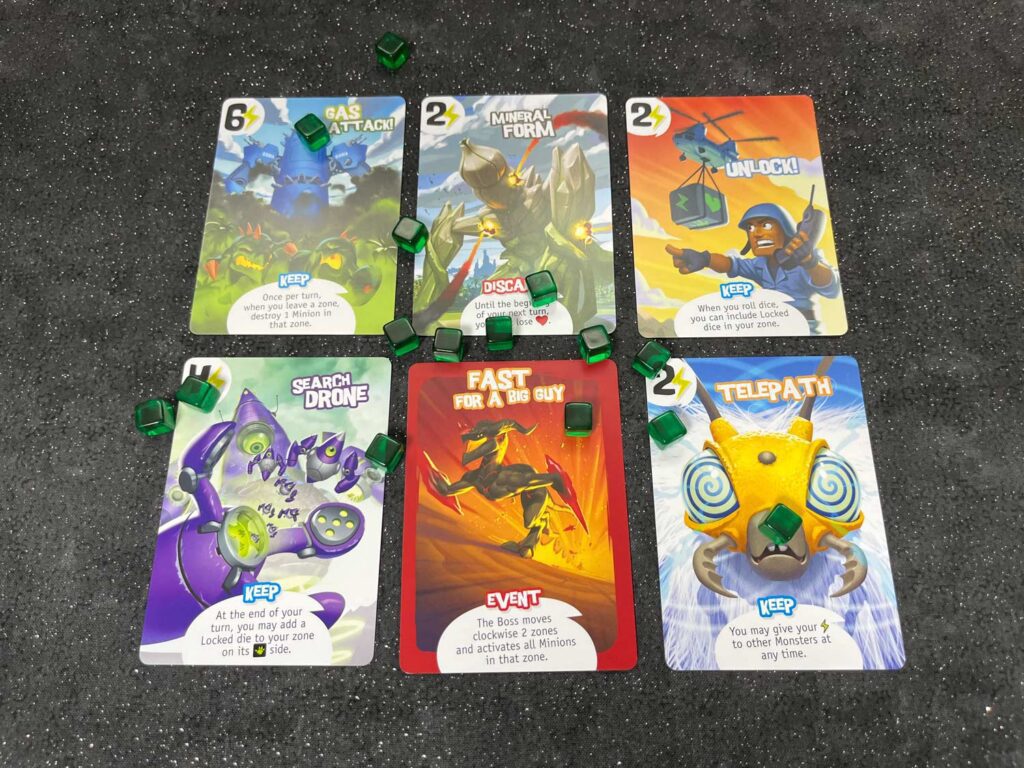
I’ve enjoyed all of my plays of King of Monster Island. It’s a perfect game for the family, kids will love throwing the dice, moving the giant monsters around, and standing shoulder to shoulder against the bad guy with mom and dad (and/or brother and sister). It’s a great game for casual gamers who just want to have some fun. And for more hardcore gamers, it can be part of a longer game night, as long as everyone involved doesn’t take it too seriously.
So after all is said and done, who is this game for?
- If you’re already a fan of King of Tokyo, then you’re probably going to love King of Monster Island.
- If you’ve played King of Tokyo and were on the fence about it, then you might actually like King of Monster Island. It breaks the mold just enough to make it interesting…plus there’s a solo mode, should that entice you.
- If you don’t like randomness or dice chucking (or fun it sounds like) then you should give this one a pass.
Now, I’m off to do some preliminary research on the formation of an Injustice League. Message me for details; make sure to practice your evil laugh.


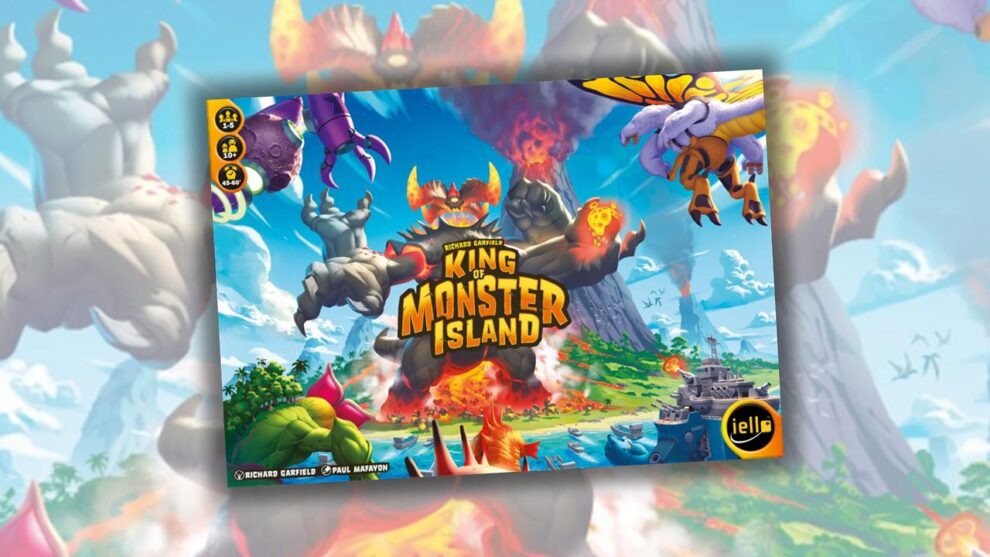


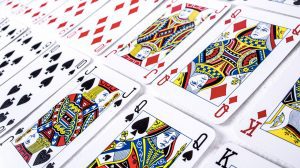
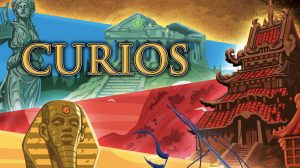
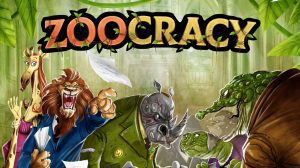




Add Comment